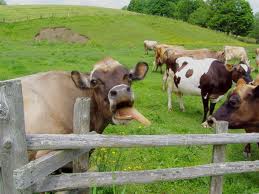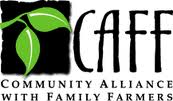As you all know by now, I am from Vermont. And although Vermont, for quite some time, was famous for having more cows than people, the scale of the agricultural sector in Vermont pales in comparison to California’s. In driving around California, I have been shocked by the size and frequency of strawberry farms, vegetable patches, and wine grapes as far as the eye can see. Vermont has a lot of agriculture, but we are known for our small, diversified farms. Before starting this program, I worked at a winery in Vermont situated on a 1,000 acre farm, and I remember thinking, “1,000 acres! That’s huge!” But in California, the norm is 10,000+ acre farms. In the San Joaquin Valley, there are 70,000 acres of just pistachios trees owned by one corporation, Paramount Farms. I know that comparing Vermont and California agriculture is literally comparing apple orchards and citrus groves, but, as I am on a quest to promote and define sustainable agriculture, I have to wonder: what is the future of California’s agriculture and what lessons can I bring here from Vermont?

As I drove through the Salinas Valley this past week, where there are endless lettuce and strawberry plots, I glanced over at the car’s thermometer. 107 degrees. It’s hot. It’s dry. Around the lush green agricultural fields are hills of dead golden grass waiting for the winter rains to bring them back to life. For many of these large agricultural areas in the state, it does not rain from April to October. Despite that fact, there are fruits and vegetables with high water demands grown in this inhospitable climate. And all of this is made possible by irrigation.

The topic on every one’s mind in these areas is water. Where to get it? How much is there? How can I secure my water rights? And some, but not many, are asking: what is the sustainable yield per acre of water for agriculture? And even less people are asking: are we planting the right crops in these areas? And finally, the topic that no one wants to talk about, Climate Change comes up: what is going to happen when it gets hotter and drought periods become worse?
The organization that I am interning for, Community Alliance with Family Farmers (CAFF), is a non-profit that advocates for sustainable agriculture, local food systems, and small scale Californian agriculture. Recently that they have become involved in California’s water issues. My boss, the policy director, has been working with strawberry farmers in the Pajaro Valley to determine if there is any way the farmers can conserve water. My job is to see if wine grape growers can reduce their water usage as well.
I spent all week in Paso Robles, CA. The east side of the AVA received 9″ of rain last year, the west side, on average, receives 22.5″ of annual rain. To me, this is shocking. There is no part of Vermont that receives less than 30″ of annual rain, and some areas get 50″ or 60″ of annual rain. So last week I spoke to grape growers who are conserving water by either not irrigating at all or by practicing regulated deficit irrigation, which is basically just irrigating when it was absolutely necessary. Now there is a lot that goes into this equation- too much to get into here- but I have come away with a few things so far. First, those that are conserving water are the smaller boutique operations. They are growers with 12 acres, 40 acres, 60 acres, not hundreds or thousands of acres. Second, these growers have picked their sites carefully to be suitable vineyard sites. This means that the vines can thrive naturally with minimal irrigation. And lastly, these growers are interested in producing small batches of unique wines, not grocery store magnums.
As I stood on the hill side of a dry farmed vineyard, complete with olive trees, oaks trees, sheep, cows, and chickens, the 110 degree heat made me want to faint, but the vines looked beautiful. They have deep roots that had found enough water to support berry growth. The owner of AmByth Estates pointed out into the distance to newly cultivated land. Gallo had just purchased huge tracts of land and is preparing them as vineyard sites, this included the drilling of 7 new well heads to irrigate the new vines. The aquifer is already being drained faster than it can replenish itself, what is going to happen now?

So after a month of interning, I am left with more questions than answers. But I expected that. California’s commercial agricultural industry is getting bigger and using more water than is sustainable. Every year more acreage is being converted to grapes, strawberries, citrus groves, and water demand will only increase. Eventually something will have to give.
I still remain optimistic though. Remember back in the beginning of this post when I talked about Vermont’s small, diversified farms? Well, that may be the answer. And they exist in California too. These farms are conserving water and implementing innovative sustainable practices- they are using hedgerows, succession plantings, increasing soil water holding capacity, and working within the limitations of the land. In addition to driving though the monster commercial farms, I have visited the smaller diversified operations here. The farms sell direct to the consumer, local restaurants, and groceries. This is where the rest of us, the consumers, come into the story, and it leads me to my last point, for now. As a consumer, I will forevermore be cognizant of where the food I purchase comes from and how it was grown. I want to make sure I am supporting the best agricultural operations and buying local. I guess when I go back to Vermont, I will be on the Cabot cheese and maple syrup diet. I cannot wait.

